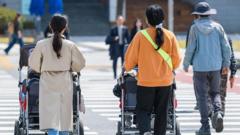
IVF Demand Offers Glimmer of Hope Amidst South Korea's Demographic Challenges
A Nation Grappling with a Declining Birth Rate
South Korea is facing a severe demographic crisis, characterized by a rapidly declining birth rate and an aging population. This trend poses significant challenges to the nation's economic stability, social welfare system, and long-term sustainability. The total fertility rate, which represents the average number of children a woman is expected to have in her lifetime, has plummeted to alarmingly low levels, sparking widespread concern among policymakers and citizens alike.
Various factors contribute to this demographic decline, including:
- Economic Pressures: The high cost of living, coupled with intense competition in the job market, places significant financial strain on young couples, making it difficult for them to afford raising children.
- Career Aspirations: Increasing numbers of women are prioritizing their careers and delaying or forgoing parenthood altogether.
- Social Expectations: Traditional gender roles and societal expectations surrounding childcare responsibilities can create additional barriers for women who wish to pursue both a career and motherhood.
- Housing Costs: The exorbitant cost of housing, particularly in urban centers, makes it challenging for young couples to establish stable households and raise families.
The Rise of IVF Treatments: A Beacon of Optimism?
In the face of this demographic crisis, the growing demand for In Vitro Fertilization (IVF) treatments is offering a small but significant glimmer of hope. IVF, a complex series of procedures used to help with fertility or prevent genetic problems and assist with the conception of a child, is becoming increasingly popular among South Korean couples struggling with infertility.
The number of IVF cycles performed in South Korea has been steadily increasing in recent years. Several factors are driving this trend:
- Increased Awareness: Greater awareness of IVF treatments and their potential to overcome infertility issues has led to increased demand.
- Government Support: The South Korean government offers financial assistance and subsidies for IVF treatments to encourage couples to pursue this option. This support makes IVF more accessible to a wider range of individuals.
- Advancements in Technology: Technological advancements in reproductive medicine have improved the success rates of IVF treatments, making it a more appealing option for couples struggling to conceive.
- Delayed Childbearing: As more couples delay childbearing, the incidence of age-related infertility increases, leading to a greater need for assisted reproductive technologies like IVF.
IVF's Potential Impact on South Korea's Demographics
While IVF treatments cannot single-handedly solve South Korea's demographic crisis, they do offer a potential avenue for increasing the birth rate, albeit on a smaller scale. Each successful IVF birth contributes to the overall population and helps to offset the decline in natural births. Furthermore, the growing demand for IVF treatments is driving innovation and investment in the field of reproductive medicine, which could lead to even more effective and accessible fertility treatments in the future.
However, it is crucial to acknowledge the limitations of IVF as a solution to the demographic crisis. IVF is an expensive and invasive procedure, and success rates can vary depending on factors such as age, health, and the underlying cause of infertility. Moreover, IVF does not address the root causes of the declining birth rate, such as economic pressures, career aspirations, and social expectations.
Addressing the Root Causes: A Comprehensive Approach
To effectively address its demographic challenges, South Korea needs to adopt a comprehensive approach that goes beyond simply promoting IVF treatments. This approach should include:
- Economic Reforms: Implementing policies that address economic inequality, reduce the cost of living, and create more stable job opportunities for young people.
- Family-Friendly Policies: Providing affordable childcare, parental leave benefits, and flexible work arrangements to support working parents.
- Gender Equality: Promoting gender equality in the workplace and at home to reduce the burden on women and create a more supportive environment for families.
- Housing Solutions: Addressing the housing crisis by increasing the availability of affordable housing options, particularly in urban areas.
Conclusion: A Combined Effort for a Sustainable Future
The growing demand for IVF treatments in South Korea offers a ray of hope amidst the nation's demographic challenges. While IVF can contribute to increasing the birth rate, it is not a silver bullet solution. A comprehensive approach that addresses the root causes of the declining birth rate, coupled with continued advancements in reproductive medicine, is essential to ensure a sustainable and prosperous future for South Korea. Only through a combined effort can South Korea hope to reverse its demographic decline and secure its place in the global landscape.
```